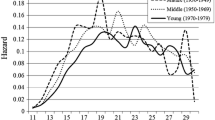Abstract
Using biannual Current Population Survey data, this paper reexamines the question of how education and occupations led to the postponement of first births among American mothers in the 1970s through 1990s. Analytical methods in earlier investigations predispose researchers to favor an “investment” model of education's effects, but an alternative method used in this analysis suggests that college attainment's major effect on age at first birth is primarily the result of years spent childless in college. Mothers-to-be in higher prestige occupations did delay motherhood longer than did those in other occupations. This study extends earlier research by examining whether or not conclusions drawn about all women (with and without children) apply to the majority of women—those who become mothers. The expansion of higher education, higher prestige occupations, and their impact on work and family decisions are discussed.
Similar content being viewed by others
REFERENCES
Burstein, Paul, R. Marie Bricher, and Rachel L. Einwohner 1995 “Policy alternatives and political change: Work, family and gender on the Congressional agenda, 1945–1990.” American Sociological Review 60:67-83.
Cherlin, Andrew 1980 “Postponing marriage: The influence of young women's work expectations.” Journal of Marriage and the Family 42:355-365.
Desai, Sonalde, and Linda J. Waite 1991 “Women's employment during pregnancy and after the first birth: Occupational characteristics and work commitment.” American Sociological Review 56:551-566.
Dobson, Coretta D., and Sharon K. Houseknecht 1998 “Black and white differences in the effect of women's educational attainment at first marriage.” Journal of Family Issues 19:204-223.
Edwards, Mark Evan 1996 “Pregnancy discrimination litigation: Legal erosion of capitalist ideology under Equal Employment Opportunity law.” Social Forces 75(1):247-268.
12001a “Home ownership, affordability, and mothers' changing work and family roles.” Social Science Quarterly 82(2):370-384.
22001b “Uncertainty and the rise of the work-family dilemma.” Journal of Marriage and the Family 63(1):183-196.
Elder, Glen H., Jr. (ed.) 1985 Life Course Dynamics: Trajectories and Transitions, 1968–1980. Ithaca: Cornell University Press.
Gerson, Kathleen 1985 Hard Choices: How Women Decide About Work, Career, and Motherhood. Berkeley: University of California Press.
Heaton, Tim B., and Cardell K. Jacobson 1999 “Persistence and change in decisions to remain childless.” Journal of Marriage and the Family 61:531-539.
Hofferth, S. L., and K. A. Moore 1979 “Early childbearing and later economic well-being.” American Sociological Review 44:784-815.
Leibowitz, Arleen, and Jacob Alex Klerman 1995 “Explaining changes in married mothers' employment over time.” Demography 32:365-378.
Marini, Margaret Mooney 1978 “The transition to adulthood: Sex differences in educational attainment and age at marriage.” American Sociological Review 43:483-507.
Modell, John 1989 Into One's Own: From Youth to Adulthood in the United States 1920–1975. Berkeley: University of California Press.
Moen, Phyllis 1992 Women's Two Roles: AContemporary Dilemma. New York: Auburn House.
Oppenheimer, V. K. 1982 Work and the Family: AStudy in Social Demography. New York: Academic Press.
Rindfuss, Ronald R. 1991 “The young adult years: Diversity, structural change, and fertility.” Demography 23:493-512.
Rindfuss, Ronald R., Karin L. Brewster, and Andrew L. Kavee 1996 “Women, work, and children: Behavioral and attitudinal change in the United States.” Population and Development Review 22:457-482.
Rindfuss, Ronald R., Larry Bumpass, and Craig St. John 1980 “Education and fertility: Implications for the roles women occupy.” American Sociological Review 45: 431-447.
Rindfuss, Ronald R., S. Philip Morgan, and Kate Offutt 1996 “Education and the changing pattern of American fertility: 1963–1989.” Demography 3:277-290.
Rindfuss, Ronald R., S. Philip Morgan, and Gray Swicegood 1984 “The transition to motherhood: The intersection of structural and temporal dimensions.” American Sociological Review 49:359-372.
11988 First Births in America: Changes in the Timing of Parenthood. Berkeley: University of California Press.
Rindfuss, Ronald R., and Craig St. John 1983 “Social determinants of age at first birth.” Journal of Marriage and the Family 45:553-566.
Rindfuss, Ronald R., Craig St. John, and Larry L. Bumpass 1984 “Education and the timing of motherhood: Disentangling causation.” Journal of Marriage and the Family 46: 981-984.
Rindfuss, Ronald R., C. Gray Swicegood, and Rachel A. Rosenfeld 1987 “Disorder in the life-course: Howcommon and does it matter?” American Sociological Review 52:785-801.
Thornton, Arland, William G. Axinn, and Jay D. Teachman 1995 “The influence of school enrollment and accumulation on cohabitation and marriage in early adulthood.” American Sociological Review 69: 762-774.
U.S. Bureau of the Census 1989 Fertility of American Women: June 1988. Current Population Reports, Series P-20, No. 436. Washington, DC: U.S. Government Printing Office.
1997 Table H1. “Percent childless and births per 1,000 women in the last year: Selected years, June 1976 to present.” Available at http://www.census.gov/ population/socdemo/fertility/fert95/ tabH1.txt.
Waite, Linda J., Frances Kobrin Goldscheider, and Christina Witsberger 1986 “Nonfamily living and the erosion of traditional family orientations among young adults.” American Sociological Review 51:541-554.
Author information
Authors and Affiliations
Rights and permissions
About this article
Cite this article
Edwards, M.E. Education and Occupations: Reexamining the Conventional Wisdom About Later First Births Among American Mothers. Sociological Forum 17, 423–443 (2002). https://doi.org/10.1023/A:1019679023616
Issue Date:
DOI: https://doi.org/10.1023/A:1019679023616




